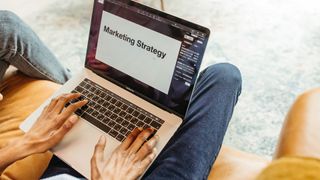The best digital channels for marketing funnel stages
Equip your marketing funnel stages with top platforms

Business owners and marketing managers are spoiled for choice when it comes to connecting with customers. For maximum impact, it’s important to match the most effective digital marketing channels with the relevant marketing funnel stages.
This helps you to develop a strong marketing strategy—using various approaches to raise awareness, generate interest, build connections, and persuade people to buy. You can then utilize the best CRM software to map and preserve these customer connections for future use in marketing and sales.
We’ve already explored what marketing funnel stages are, and the customer journey through each one. We’ve also highlighted the main marketing channels and how each of them works. Here, we’re bringing those approaches together, and suggesting ways to use each digital channel based on the specific marketing funnel stage.
We’ll start by reminding you of the marketing funnel stages and the most common digital marketing channels. Then, we’ll share examples of using these channels based on each funnel stage, and suggest some of the best marketing software for each one.
Recapping the TOFU, MOFU, and BOFU marketing funnel stages

Specific marketing funnel models do vary, but they share some common characteristics—namely, the “level” of the funnel that your potential customers are currently in. They are:
- Top Of Funnel or TOFU: raising awareness of your business, brand, products, and services to get potential customers to your website
- Middle Of Funnel or MOFU: providing information about your products and services, and creating a connection with your leads
- Bottom Of Funnel or BOFU: persuading customers to commit and buy from you
Learn about these stages in our guide outlining what is a marketing funnel and how does it work?
Recapping five of the most popular digital marketing channels
There are dozens of different marketing channels. Here are five of the most popular when it comes to marketing your business online:
Get daily insight, inspiration and deals in your inbox
Get the hottest deals available in your inbox plus news, reviews, opinion, analysis and more from the TechRadar team.
- Pay-per-click (PPC) advertising: shows ads for your products and services when people type related keywords into a search engine; useful at all marketing funnel stages
- Display advertising: displays text, image, and video ads across different websites in similar areas to your business; most useful for TOFU and MOFU stages
- Social media marketing: inserts ads into people's feeds across social media networks like Facebook, Instagram, Twitter, and LinkedIn; most useful for TOFU and MOFU stages
- Content marketing and SEO: creates content for your website and other channels so that you rank highly in organic search results; most useful for MOFU and BOFU stages
- Email marketing: markets to people who have signed up for your email list; most useful for MOFU and BOFU stages
You can find out more in our Marketing 101 guide, discussing the marketing basics for small business owners.
How to use marketing channels for the TOFU marketing funnel stage

In this stage of the marketing funnel, you want to raise awareness of your business, brand, products, and services. The most relevant TOFU channels are:
- PPC advertising
- Display advertising
- Social media marketing
- Content marketing
Here’s how to use each channel to raise awareness as part of TOFU activities.
PPC advertising for the TOFU marketing stage
- Bid on “broad” and “phrase” search terms in your niche, and create general ads that point to your business website and brand as a whole
- Create high-level landing pages that provide a helpful overview of your business, products, and services
- Track and refine your broader search terms to maximize return on investment (ROI) and brand awareness
Display advertising for the TOFU marketing stage
- Build a strong brand and business identity that you can show through text, images, videos, and other media
- Identify websites that are in the same broad niche as your business, and approach them to discover what display ad networks they use
- Create ads and other display materials that highlight your brand, business, and high-level products and services
- Review your display ad analytics to discover the main traffic drivers for your website
Social media marketing for the TOFU marketing stage
- Review your marketing personas, and create social media audience groups based on broad interests and demographics
- Create social media ads that feature your branding and business identity, to help raise awareness
- Build social media posts to enhance brand positioning and generate interest as people scroll through their social media feeds
Content marketing and SEO for the TOFU marketing stage
- Target organic SEO keywords for general information about your business, products, and services
- Create high-level landing pages and content for the most common keyword terms
- Focus on TOFU user intent, which is going to be an initial awareness of your business, and an overview of what you do and what you sell
How to use marketing channels for the MOFU marketing funnel stage

In this stage of the marketing funnel, leads want to discover more about your specific products and services. All of our five marketing channels are useful for the MOFU stage.
PPC advertising for the MOFU marketing stage
- Bid on “phrase” and “exact” search terms for your products and services, and create specific ads that point to informational, educational, and supportive website information
- Create customer-specific landing pages that answer questions, detail the features and benefits of your products, and provide a helpful overview of your business, products, and services
- Get detailed information on PPC search terms and conversions, and create additional ads and landing pages to meet what people are searching for
Display advertising for the MOFU marketing stage
- Expand your publisher research to find non-competitor websites in similar niches to your products and services
- Create targeted ads and other display materials that share the features and benefits of your products, and how they can solve problems for your customers
- Experiment with ads that speak to different customer personas and products, and focus on the most effective approaches
Social media marketing for the MOFU marketing stage
- Narrow down your social media audience interests to target people more interested in your specific products and services
- Create ads and posts that directly speak to particular problems or solutions for customers, and that clearly show the benefits and features of your products
Content marketing and SEO for the MOFU marketing stage
- Target more specific organic SEO keywords that inform and educate users about your products and services
- Create more in-depth blog posts, articles, case studies, and lead magnets that answer specific questions, show how your products can help, and build authority in your niche
- Focus on MOFU user intent, which is going to be deeper investigation of your product features and benefits; comparisons with competitors; use cases; and the ways your offerings will make the customer’s life better
Email marketing for the MOFU marketing stage
- Create an email signup form on your website to add people to a mailing list
- Use lead magnets and incentives to get people to join the list
- Build an email strategy and campaign, typically a series of “drip” messages that provide helpful information to subscribers and share information about your products and services
- Experiment with different email subject lines, message content, formats, and other factors to maximize your email open and click-through rates
How to use marketing channels for the BOFU marketing funnel stage

In this stage of the marketing funnel, leads are ready to buy. You just need to encourage them to follow the call-to-action and hit that buy button. The most relevant BOFU channels are:
- PPC advertising
- Content marketing
- Email marketing
PPC advertising for the BOFU marketing stage
- Bid on specific “buy now” related keywords for your products and services
- Link directly to product information pages with prominent purchasing calls to action
- Track your conversion analytics and refine your campaigns further
Content marketing and SEO for the BOFU marketing stage
- Target very specific, organic, long-tail SEO keywords that directly address a buyer’s intent
- Create product and service description pages, with clear calls to action linking to your purchase or signup process
- Experiment with on-site promotions and incentives to nudge customers into buying now
- Focus on BOFU user intent, which is a desire to purchase
Email marketing for the BOFU marketing stage
- Create email messages that offer incentives to purchase like discount codes or free shipping
- Mix these messages in towards the end of your drip campaigns
- Carefully track open rates and click-throughs that do not result in purchases
- Build follow-up emails to these subscribers to provide extra incentives to visit and buy
- Experiment with different email subject lines, message content, formats, and other factors to maximize your email open and click-through rates
Experiment with and refine your digital channels for each marketing funnel stage
The key to good marketing and a strong ROI is to track your metrics and see what’s working—and what’s not.
Keep a close eye on your keywords, click-through rates, and conversions. Try out different headlines and content to see what your customers engage with. Split-test ads and landing pages and learn what’s most effective. Then, implement the changes to maximize your conversions while minimizing your costs.
The best marketing software for your digital channels and marketing funnel stages

Fortunately, there’s some great software out there to help you create content, manage marketing channels, automate your business marketing, and track what’s working.
- PPC keywords, campaign management, and ad creation: Google AdWords
- Tracking visitors to your websites, how they got there, and what they did: Google Analytics
- Display advertising networks: Google Adsense, AdRoll, RollWorks, Adstream
- Social media marketing, tracking, and posting: Hootsuite, Buffer, Sprout Social
- Content marketing keywords and tracking: Google Search Console, Google Analytics, HubSpot, SEMRush, and other tools
- Email marketing and tracking: Constant Contact, MailChimp, and other tools
Combine these tools with your marketing strategy to create powerful, automated messages that engage with your customers, get them to your website, and persuade them to buy!
Paul is a professional writer who creates extensively researched, expert, in-depth guides across business, finance, and technology. He loves the challenge of taking complex subjects and breaking them down so they are easy to understand. He can quote 'The Princess Bride' in its entirety and believes the secret to good writing is Earl Grey tea.
Most Popular





